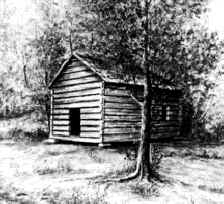![]()
THOMAS NEWTON HUGHES
IN THE CIVIL WAR
At the outbreak of the Civil War, Thomas Newton Hughes entertained the Confederate Service as a volunteer and member of a Company know as the Shelby Grays. The writer is unable to give the company or regiment╣, in which he originally served but recalls, from a statement made in his presence, by Thomas Newton Hughes, and also later made to him by a comrade in service, part of his service was with General Cheatham's Brigade.
Concerning his service as a Confederate Soldier, this further is recalled from his statements:
He participated in the two day battle at Shiloh on April 6 -7, 1862. At some point of time, during his service, he became ill and had to return home for recovery. After about three months he had recovered enough to return to service, and became a member of General Nathan Bedford Forrest's Calvary Regiment, in which he continued to serve until the close of the war. He was in the engagement at Brice's Crossroads near Holly Springs, Mississippi. He related to the writer the facts concerning the raid which was made into Memphis by a portion of Forrest's Regiment, in August 1863. At this time and at the close of the war he was serving with the rank of Lieutenant. The title Colonel, by which he was familiarly called, during the later years of his life, was merely an honorary title, not one he really enjoyed.
No other details concerning engagements, during the Civil War, in which he participated, are known to the writer, for the reason the subject was reluctant to discuss his war experiences, sometime commenting, "He preferred to forget it all."
Note: The editor of these pages does not know the identity of the interviewer and author of the above paper. The reference to 'writer' in this paper, refers to the unknown author. The paper was dated 1941.
╣Records in the Tennessee State
Library and Archives indicate that T. N. Hughes was a second lieutenant in Company
"E", of the 9th Tennessee Confederate Infantry, which was formed in
Shelby County. The records also give his date of commision as May 24, 1861. (note:
the organization date of the 9th Tennessee was May 22, 1861.)
Bib: Information provided by Chad Gray, Archival Assistant and researched by
Mary Kay Dancy Smith. March 28, 2000.
Some of Thomas Newton Hughes' Engagements
FORREST'S RAID INTO MEMPHIS
When a force marched out against Forrest's Troops they might have bagged him if he fought along regular lines. Without consulting anybody, he fought most irregularly. Forrest took 1500 men on a dawn raid into Memphis. While he actually defeated the grandest of all expeditions by raiding their base, to the men in his command the satisfaction was purely personal. Memphis was the home of many. Forrest had lived and made his success there before the War, and the town was about the most splendid of all the oases the Union kept for it's people in the South. For men starving in their own desolate countryside, and reading of the lavish 'goings-on' of the occupiers, of their own hometown, it must have been a satisfaction to send the invaders scurrying though the streets. It gave one boy the chance to ride by and wave to his mother and sisters at their window.
BRICE'S CROSSROADS, MISSISSIPPI, June 10, 1864
Since that ferocious man of violence had gone on his own in the preceding fall, from the nucleus of remnants of his old command, he had raised a well-gunned Calvary force of 5000, In raising this force, Forrest showed himself to be a highly effective one-man conscription bureau: he grabbed up infantry deserters, conscript evaders and likely-looking citizens who should be conscripted. Forrest became the greatest mobile striking force in the South, and the one most feared by Sherman.
Sherman, ordered out from Memphis, a veteran Calvary force, double Forrest's size, with the new breach-loading carbines and twenty-two artillery guns. In one of the small masterpieces of the war, Brice's Crossroads, Forrest routed his enemy, which included the Grierson who had enjoyed finding the Confederacy a shell when he raided through Mississippi, unopposed, the year before
BATTLE OF SHILOH, April 6 & 7, 1862
Shiloh
Church...Painted by Capt. A.M. Connett
24th Indiana Vol. Infantry
Shiloh, a Hebrew word for 'place of peace', was also a battle where both the Federals and the Confederates sustained heavy losses. General US Grant and his 40,000 man Federal force, was on the offensive and marching toward Corinth, Mississippi. Awaiting reinforcements the Federals had camped around the tiny Shiloh Church near the banks of the Tennessee River. At dawn on the 6th of April, the Confederate Army, moving north from Corinth, launched a surprise attach. Grant's troops were in confusion and one position after another fell before the Rebel attack. Despite strong resistance at Hornet's Nest and the Peach Orchard - where blossoms "floated down on the firing line like a gentle pink rain" - the Federal Army was pushed back to the river by day's end.
The arrival of reinforcements during the night gave the Union the upper hand the next day. The Confederates continued to fight fiercely but were outnumbered and by evening were forced to retreat. Both sides sustained heavy loses and in those two brutal days, they could count 24,000 men dead, wounded,or missing.
Still existing today is Bloody Pond, where soldiers from both sides stopped to bathe their wounds, turning the water red.
The Battle of Shiloh proved to be a major victory for the Federals as they continued on and captured the Confederate railroad at Cornith, Mississippi.
BACK TO MILITARY RECORDS INDEX